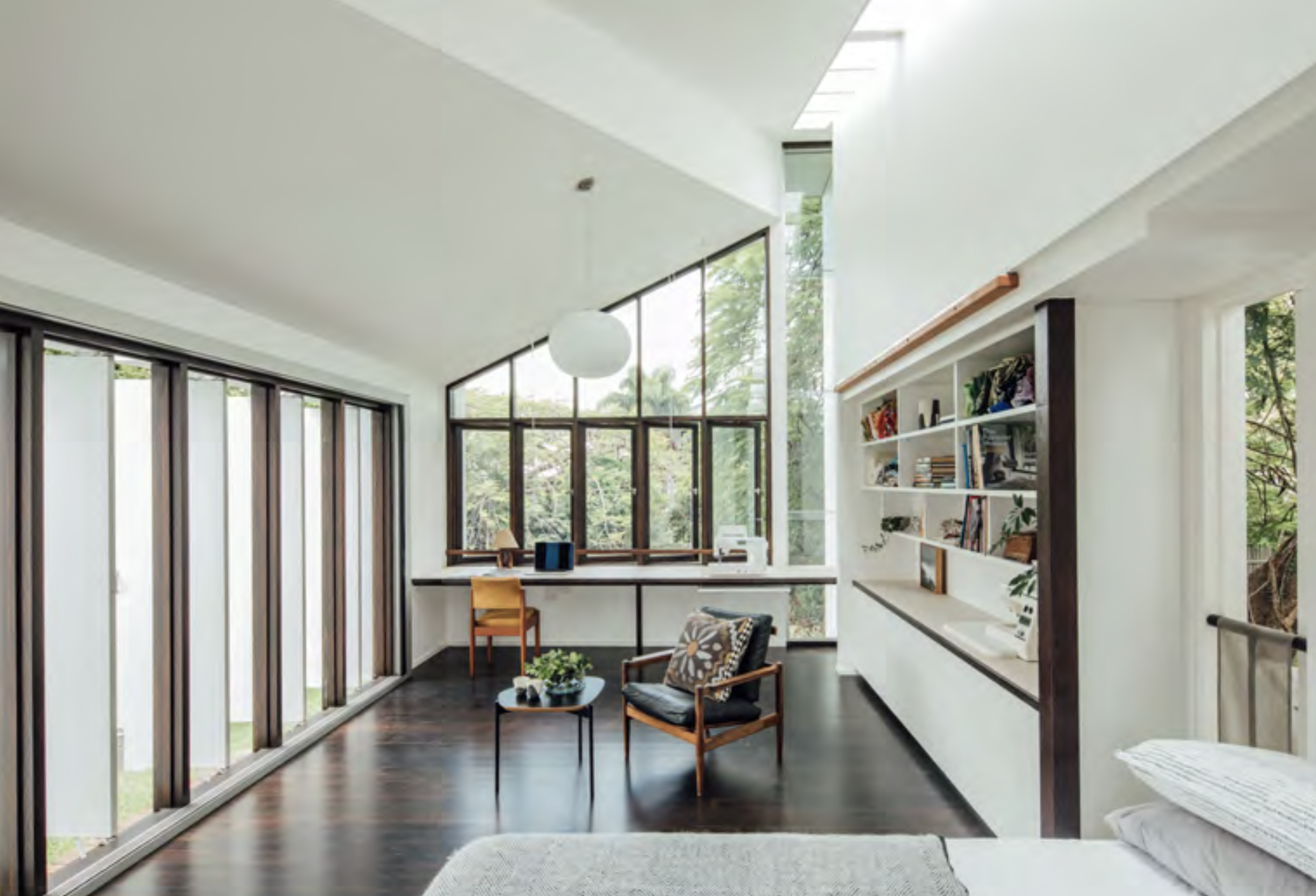Water wise flood-resilient design in action
Modern Green Homes Sanctuary - Issue 60 - Flood Resilience Special
Retrofit tips for fast flood recovery; sustainable tapware; mid-century gem restored; slow the flow in your garden.
By: Anna Cummings
Location: Yeronga, QLD | Photography: Shantanu Starick
Going with the flow
Fiona and Steve’s rejuvenated Brisbane home features a new multi-use room as well as clever water management and landscaping to handle overland flow.
Right on the river, the Brisbane suburb of Yeronga has seen its fair share of floods. Steve and Fiona are long-time local residents: “We were living in the area in 2011 and were aware of the characteristics of that flood,” says Steve. “We’re very fortunate that our current house is on higher ground so we don’t have to deal with Brisbane River flooding, but it has an overland flow overlay associated with a gully across the back third of the property.”
What might have dissuaded other buyers, though, hydro engineer Steve saw as an opportunity and a challenge. “You can look at the overland flow path in two ways – as a constraint, or as a natural feature that’s an asset,” he says. “Such a path is a vegetation corridor and a fauna movement corridor. If you don’t put structures that can get damaged in it, then it’s a fantastic bit of landscape.”
Stormwater management and landscaping to accommodate the overland flow were important aspects of the couple’s renovation plan for their little worker’s cottage – along with making the spaces more useable, removing the air conditioning, and reducing energy use. “The house was pretty small, with minimal insulation,” Steve says. “In particular, the living space on the west was blisteringly hot in summer, which wasn’t helped
by paving all down the west side of the house.”
Working with architect Tim Bennetton, Fiona and Steve settled on a plan that involved the removal of a couple of internal walls, a small pop-out to the west to extend the living area and accommodate a new laundry, and an airy semi-attached pavilion extension to the rear that has been deliberately designed to fulfill many functions. “It can be a home office, a music room, a craft studio or a guest bedroom,” says Fiona. There is a fold-down wall bed with a screening curtain that can be pivoted to run across the space for privacy. “It’s about making spaces work harder, rather than adding more rooms,” explains Tim.
The new floor plan, plus extensive operable windows and shutters, catches breezes from every angle. “We added insulation and what we call ‘vent boxes’
to the western side of the existing house,” Tim says. “These plus new adjustable slatted awnings allow the whole house to breathe while blocking the hot western sun, and meant we could keep the existing windows.” Fiona says that the house is much more liveable in summer now, even without air conditioning. “It’s only on the hottest days that the humidity can become a challenge.”
Outside, the western paving was removed and replaced with permeable surfaces and planting, helping to cool the house and reduce stormwater runoff. A 22,000-litre tank buried beneath the front courtyard captures almost all the rainwater falling on the roof; thanks to the fall of the block towards the rear, the overflow from the tank is directed to a raingarden in the backyard where it’s filtered and dispersed. A handful of times a year it rains heavily enough for the raingarden to overflow too.
Steve and Fiona reinstated a creek bed across the back of the property, planting around it with bird-attracting local species. “Four years on, it’s really starting to take shape,” says Steve. “The creek is dry most of the time, but when we get
a lot of heavy rain it turns into a bit of a billabong.”
He points out that the rocks and plants slow down the water flow, reducing erosion and allowing sediment to settle. “It works brilliantly. It causes us zero stress when there’s rain coming. The water in the backyard doesn’t cause any damage – that bit of the garden enjoys it.”
Tim agrees, and encourages all his clients to think about managing overland flow in this way: “When designed properly, you get to experience a seasonal stream that is attractive, useful and celebrates the different seasons.”
House Specifications
HOT WATER
Existing electric hot water system set to heat using solar generation
RENEWABLE ENERGY
7.75kW solar PV system
WATER SAVING
Allcast Precast 22,000L concrete water tank under front courtyard collects rainwater from all roofs and is plumbed to laundry and toilets
Tank overflow directed to raingarden and dry creek landscaping in back garden
Sponge City overland flow drainage strategy incorporated into stormwater and landscape design; see below for more
PASSIVE DESIGN, HEATING & COOLING
Large northern window to new pavilion for natural light and solar gain
Pavilion roof and ceiling rise toward the south to make the most of the views to the back garden and surrounding trees, and to create a chimney effect to exhaust hot air
Insulation, ‘vent boxes’ to existing windows and draped slatted awnings added to western side of existing house for shade, ventilation and thermal control
Some existing internal walls removed for more natural light and ventilation
ACTIVE HEATING & COOLING
Hunter Pacific Concept 2 ceiling fans to bedrooms, living area and deck
Existing air conditioning system removed
BUILDING MATERIALS
New pavilion:
Pine weatherboard and unpainted magnesium oxide board cladding
Zincalume roof
Solid-core doors used for adjustable panels on eastern facade
Australian northern beech floorboards
Insulation: polyester batts to pavilion walls and ceiling (R2.5) and underfloor (R2), and to western wall of existing house (R2.5)
Spotted gum decking
WINDOWS & GLAZING
New pavilion: timber-framed fixed and casement windows by Darra Joinery; tall sashless sliding window to south allows venting of hot air; polycarbonate skylight with custom cover for summer
Solatube skylight to existing house
LIGHTING
LED lights from Lumen8
OTHER ESD FEATURES
The design incorporates water sensitive urban design (WSUD) and Sponge City principles, meaning decreased stormwater runoff from the property, reduced mains water use and increased drought and flood resilience. Principles include:
Replacement of driveways and paved areas with permeable landscaped surfaces
Rainwater harvesting, storage and use for toilet flushing and clothes washing
Active engagement of the property’s overland flow path.
Site Plan
Designer
Tim Bennetton Architects
Builders
Greg Thornton Constructions
Charles Warren Constructions
Project Type
Renovation and extension
Location
Yeronga, QLD (Jagera and Turrbal Country)
Cost
$490,000
Size
House 150m2 (new built area 50m2)
Land 690m2
Energy Rating
6 Stars
Energy Assessor
Energy Rating Consulting




